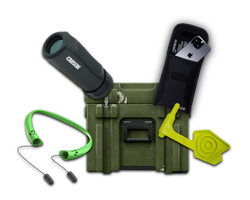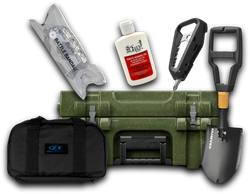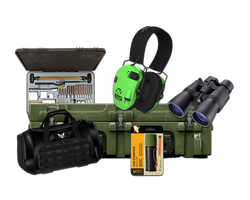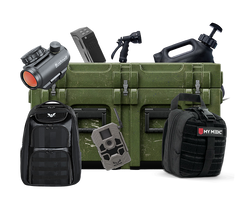How to Pack a Sleeping Bag for Backpacking: A Comprehensive Guide
Table of Contents
- Introduction
- Understanding Your Sleeping Bag
- How to Pack a Sleeping Bag for Backpacking
- Maintaining Your Sleeping Bag
- Crate Club Gear Recommendations
- Conclusion
- FAQ
Introduction
Imagine you're standing at the trailhead, the sun is just beginning to rise, and you can already feel the excitement of adventure in the air. Yet, amidst that thrill, there's a nagging thought: How am I going to fit everything into my backpack? If you've ever found yourself wrestling with a bulky sleeping bag, unsure of how to pack it efficiently, you're not alone. Proper packing is crucial for a successful backpacking trip, and packing your sleeping bag is a key component of that process.
A sleeping bag is not just a cozy cocoon for your nighttime adventures; it’s an essential piece of gear that can take up a significant amount of space in your pack. The way you pack your sleeping bag can influence your comfort on the trail, your ability to access gear when you need it, and even how effectively you carry your load. Understanding how to pack a sleeping bag for backpacking is not only practical; it's a skill that can enhance your overall outdoor experience.
In this post, we will delve into the nuances of packing a sleeping bag for backpacking, covering everything from choosing the right bag to packing techniques that maximize space and maintain your bag's insulation. We will also explore how Crate Club’s curated gear can enhance your outdoor adventures, helping you prepare for every situation you may encounter.
What You'll Learn
By the end of this article, you will have a comprehensive understanding of:
- The importance of packing your sleeping bag correctly
- Different types of sleeping bags and their packing requirements
- Techniques for compressing and organizing your gear
- Tips for maintaining your sleeping bag's insulation and longevity
- Recommendations for quality gear from Crate Club to support your backpacking journey
Get ready to transform how you pack your sleeping bag and elevate your backpacking game!
Understanding Your Sleeping Bag
Types of Sleeping Bags
Before we dive into packing techniques, it’s essential to understand the types of sleeping bags available and how they differ in terms of packing and performance.
-
Down Sleeping Bags:
- Pros: Lightweight, compressible, and excellent insulation.
- Cons: Expensive and loses insulation when wet unless treated with a waterproofing agent.
- Packing Tip: Down bags generally compress well. Use a compression sack to minimize space.
-
Synthetic Sleeping Bags:
- Pros: More affordable, retains insulation when wet, and dries faster.
- Cons: Heavier and bulkier than down.
- Packing Tip: Synthetic bags can be stuffed or stowed in their stuff sack. Compression sacks may also work but can be less effective than with down bags.
-
Quilts:
- Pros: Lightweight and versatile, often used by ultralight backpackers.
- Cons: May not provide as much warmth as traditional sleeping bags.
- Packing Tip: Typically, quilts can be stuffed into a stuff sack or rolled and stuffed into your pack.
Choosing the Right Sleeping Bag
When selecting a sleeping bag for your backpacking trip, consider the following factors:
- Temperature Rating: Ensure the bag is rated for the conditions you expect to encounter. A bag rated for cooler temperatures may be necessary if you plan to camp in colder climates.
- Weight and Compressibility: If you’re concerned about pack weight, look for lightweight options that compress well.
- Shape and Size: Mummy bags offer better insulation and weight savings, while rectangular bags provide more space but may be bulkier.
Selecting the right sleeping bag sets the stage for effective packing and enhances your comfort during your adventure.
How to Pack a Sleeping Bag for Backpacking
Step 1: Prepare Your Sleeping Bag
Before packing, ensure your sleeping bag is clean and dry. A dirty or damp sleeping bag can lead to mold and mildew, impacting its insulation properties. If you're using a down sleeping bag, consider fluffing it up to restore loft before packing.
Step 2: Use a Compression Sack
For maximum efficiency, a compression sack is an invaluable tool. Here’s how to use one effectively:
- Place the Sleeping Bag Inside: Open the compression sack and stuff the sleeping bag inside. If you have a down sleeping bag, ensure that you don’t compress it too tightly to preserve its loft.
- Compress the Sack: Once the bag is inside, start compressing by pulling the straps on the sack. This will minimize the volume significantly, allowing for easier packing.
Step 3: Choose the Right Location in Your Backpack
The placement of your sleeping bag within your backpack is crucial for balance and accessibility. Here are some common practices:
- Bottom Packing: Most backpackers place their sleeping bag at the bottom of the pack. This method helps create a stable base for the rest of your gear and keeps the sleeping bag protected.
- Side or Vertical Packing: If you have a larger bag or specific pockets, you can try side or vertical packing. This approach helps balance the load but may require more care when securing the bag.
Step 4: Fill Gaps with Other Gear
Once your sleeping bag is securely packed, fill gaps in your backpack with other items:
- Clothing: Use clothing items to fill empty spaces around the sleeping bag. This method not only saves space but also provides insulation and protection for your sleeping bag.
- Lightweight Gear: Place lightweight gear, such as a sleeping pad, on top of or beside the sleeping bag to optimize space.
Step 5: Secure Your Pack
After packing your sleeping bag and other gear, ensure everything is secured within your backpack. Tighten compression straps and close zippers fully to prevent shifting during your hike.
Maintaining Your Sleeping Bag
Storage Tips
Proper storage is essential for maintaining the loft and insulation of your sleeping bag:
- Avoid Long Compression: Don’t store your sleeping bag in a compressed state for extended periods. Instead, store it loosely in a large cotton or mesh bag to allow the down to breathe.
- Keep it Dry: Always ensure your sleeping bag is dry before storage. Moisture can lead to mildew and a loss of insulation properties.
Cleaning Your Sleeping Bag
Regular cleaning helps maintain the integrity of your sleeping bag:
- Follow Care Instructions: Always check the care label on your sleeping bag for specific cleaning instructions. Most down bags require gentle washing, while synthetic bags can be washed in a regular machine.
- Use a Front-Loading Machine: If possible, use a front-loading washing machine to avoid damaging the bag. Use a gentle detergent and consider using dryer balls when drying to help maintain loft.
Crate Club Gear Recommendations
As you prepare for your backpacking adventure, consider exploring the offerings of Crate Club. With subscription services that cater to various skill levels, you can find high-quality gear carefully curated by professionals.
Crate Club Subscriptions
Crate Club offers four subscription tiers to suit different outdoor enthusiasts:
- Lieutenant Tier ($49.99/month): Great for beginners, this tier includes essential survival tools, self-defense gear, and EDC items.
- Captain Tier ($99.99/month): For those looking for a mix of survival and tactical gear, this tier offers medical kits, outdoor essentials, and more.
- Major Tier ($199.99/month): Designed for experienced survivalists, this tier includes premium gear that has passed rigorous tests.
- General Tier ($399.99/quarterly): This tier features real-issue tactical gear used by professionals, perfect for serious adventurers.
Explore the Crate Club subscriptions here to enhance your gear collection and ensure you’re fully prepared for your next adventure.
Crate Club Shop
In addition to subscription services, Crate Club offers a shop with a range of tactical gear and survival tools. Discover items that can elevate your outdoor experience and keep you prepared for any situation. Visit the Crate Club Shop here.
Conclusion
Packing your sleeping bag efficiently is an integral part of preparing for any backpacking trip. By understanding the different types of sleeping bags, employing effective packing techniques, and utilizing quality gear from Crate Club, you can enhance both your comfort and readiness on the trail.
Remember, the way you pack can significantly impact your hiking experience. Take the time to pack strategically, and you will find that the weight feels lighter, the trail seems more manageable, and your outdoor adventure becomes truly enjoyable.
FAQ
1. Can I pack my sleeping bag loose?
Yes, you can pack your sleeping bag loose, especially if it’s a down bag. However, using a compression sack can help save space and keep your pack organized.
2. How do I prevent my sleeping bag from getting wet?
Always pack your sleeping bag in a waterproof stuff sack or use a pack liner to protect it from rain and moisture.
3. Should I use a stuff sack or a compression sack?
A compression sack is ideal for minimizing space, while a stuff sack can be used for easier packing. Choose based on your needs and the type of sleeping bag you have.
4. What’s the best way to store my sleeping bag when not in use?
Store your sleeping bag loosely in a breathable bag to maintain its loft. Avoid long-term compression.
5. How often should I clean my sleeping bag?
Clean your sleeping bag as needed, usually after several trips or if it becomes dirty. Always follow the care instructions provided by the manufacturer.
By mastering the art of packing your sleeping bag and investing in quality gear, you’re setting yourself up for success on your outdoor adventures!
Share this article



